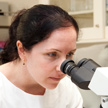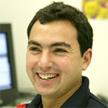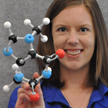
Elise Pelzer
Favourite Thing: Explore..they say microbiologists have a big job in a small world. I get a kick out of being able to grow and see the bugs (a bit smelly though!). They out number our cells 10:1 but we cannot see them with the naked eye. It is very cool to see them using culture and microscopy (light, confocal and electron). They grow in funky patterns, particularly when they are grown in liquid culture media.
My CV
School:
Saint Rita’s College (1989-1993)
University:
I completed each of my degrees at the Queensland University of Technology. Bachelor of Applied Science and Arts (Microbiology and Biotechnology), coursework Master’s (Biotechnology) part-time while working at QIMR. PhD in reproductive health (2008 -2011).
Work History:
While studying my undergrad degree I worked as a nurse and cord blood collector. As a scientist, I have worked at the Queensland Institute of Medical Research, Queensland University of Technology and the Wesley Research Institute.
Employer:
The Women’s Health Lab at the Wesley Research Institute
Current Job:
I work as a scientist (post doctoral research fellow)
Me and my work
I grow and identify bugs (microorganisms) from the upper reproductive tract… the text books would have you believe that if you do not have an infection, then these sites are sterile…not true!
I use various microscopy techniques including scanning electron microscopy, in which I treat the samples with a heavy metal and then coat the samples with a very fine layer of gold. When we fire electrons at the samples under a vacuum, we are able to see the top surface details very clearly. In my first image there is a blood clot within the Fallopian tube. The red blood cells are stuck together by sticky fibrin. They are sitting on top of the cells lining the Fallopian tube – the hairy looking cells are the ciliated cells and the flatter cells with tiny ridges are the secretory cells. The second image was collected using confocal microscopy. We used fluoresecent dyes to stain a mouse egg and its chromosomes (DNA). A laser was used to make the stains fluoresce and then we could see the outline of the egg and the chromosomes. Because the chromsomes are yellow, we know that the DNA has been chopped up and damaged.
My Typical Day
I go to the operating theatre to collect the tissue from the surgeon and then take it to the pathologist (for gross cut-up) and then head back to the lab to start the microbiology screening for the bugs.
What I'd do with the money
I would organise a lab visit for students to process some of their own samples to see what bugs they are carrying.
My Interview
How would you describe yourself in 3 words?
Persistent, resilient and short
Who is your favourite singer or band?
Florence and the Machine
What is the most fun thing you've done?
Bungy jumping
If you had 3 wishes for yourself what would they be? - be honest!
To be able to control time, to have all of my experiments work (the first time) and to be taller!
What did you want to be after you left school?
A scientist, but I thought I would like diagnostic medical science. For me, I like the challenge of research where my endless questions always create new problems for me to solve.
Were you ever in trouble in at school?
Not really, I’m the oldest sibling in my family and I was a bit of a goody goody! I only remember being in trouble one time, it was for throwing fruit in the playground.
What's the best thing you've done as a scientist?
The best is yet to come…
Tell us a joke.
Sports followed
Rugby League
Favourite team
Brisbane Broncos…my husband’s idea of a family outing for our three daughters is the footy!
My profile link:
https://lithium.imascientist.org.au/profile/elisepelzer/
 Print this profile
Print this profile








 Print this profile
Print this profile